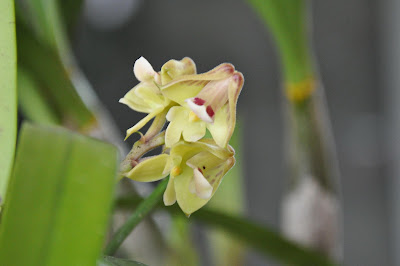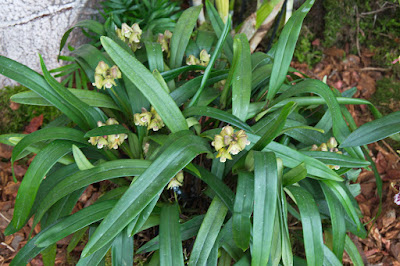Polystachya galeata is found in Cameroon, Congo, Gabon, Ghana, Guinea, Ivory Coast, Liberia, Nigeria, Sierra Leone, Zaire and Angola. Its grow in lowland and submontane rainforest at elevations of 400 to 1000 meters.
Polystachya galeata also called as The Helmut-Shaped Polystachya, Bulbophyllum galeatum, Dendrobium galeatum, Dendrorchis galeata, Graphorchis cucullata, Polystachya babilonii, Polystachya cucullata, Polystachya galeata var. babilonii, Polystachya gilletii, Polystachya grandiflora, Polystachya macrantha, Polystachya quinqueloba, is a species of the genus Polystachya. This species was described by Heinrich Gustav Reichenbach in 1863.
IDENTIFY POLYSTACHYA GALEATA ORCHID PLANT
Polystachya galeata is found in Cameroon, Congo, Gabon, Ghana, Guinea, Ivory Coast, Liberia, Nigeria, Sierra Leone, Zaire and Angola. Its grow in lowland and submontane rainforest at elevations of 400 to 1000 meters.
It is a medium sized, 16-40 cm tall, hot to warm growing epiphyte with cylindrical, 2.2-20 cm long, 0.2-0.9 cm in diameter pseudobulbs forming small clumps carrying a single, apical, oblanceolate or strap shaped, leathery, 6-28 cm long 8-60 mm wide leaf.
The Helmut-Shaped Polystachya blooms on an erect, unbranched, 8 to 25 cm long, several flowered inflorescence with strongly scented flowers occuring in the fall in cultivation. The flowers are large, green, greenish yellow, yellow, pink or pure white, more or less purple or brown spotted inside.
POLYSTACHYA GALEATA ORCHID PLANT CARE AND CULTURE
Cultural information should only be used as a guide, and should be to be adapted to suit you. Your physical location; where you grow your plants, how much time you have to devote to their care, and many other factors, will need to be taken into account. Only then can you decide on the cultural methods that best suit you and your plants.
Light:
Polystachya galeata needs a light level of 25000-35000 lux. Light should be filtered or diffused, and plants should not be exposed to direct midday sun. Strong air movement should be provided at all times.
Temperature:
Throughout the year, days average 25-31°C, and nights temperature at average 16-19°C, with a diurnal range of 7-12°C. The warmest days, coolest nights, and greatest diurnal range of the year occur during the drier period in winter and early spring.
Humidity:
The Helmut-Shaped Polystachya need the humidity of 80-85% from late spring through autumn, dropping to 70-75% in winter and early spring.
Substrate, growing media and repotting:
Polystachya galeata are normally grown in relatively small pots or baskets filled with an open, fast-draining medium that retains some moisture after watering. The standard fir-bark mixes work well for many growers.
Plants may also be mounted tightly to a tree-fern slab. If mounted, however, high humidity must be maintained and the plants watered at least once daily in summer. Several waterings a day may be necessary for mounted plants during extremely hot, dry weather.
Repotting, mounting, or dividing should be done only when new root growth is just starting. This allows the plant to become established in the shortest possible time with the least amount of stress.
Watering:
Rainfall in the habitat is heavy from spring until late autumn. Amounts then decrease rapidly into a somewhat drier season in winter. Even during this period of reduced rainfall, however, additional moisture is available from heavy dew and late-night mist, so there is not an extended or severe dry season. Cultivated plants should be watered often while actively growing, but drainage must be excellent with good aeration around the roots.
Fertilizer:
1/4-1/2 recommended strength, applied weekly when plants are actively growing. You can use a balanced fertilizer throughout the year; but also can use a high-nitrogen fertilizer from spring to midsummer, then switch to one high in phosphates in late summer and autumn.
Rest period:
Growing conditions should be maintained all year. Water should be reduced somewhat for Polystachya galeata in winter, particularly those grown in the dark, short-day conditions common in temperate latitudes, but they should not be allowed to dry out completely. Fertilizer should be reduced or eliminated until new growth starts in spring and heavier watering is resumed.















Great advice, thank you
ReplyDelete